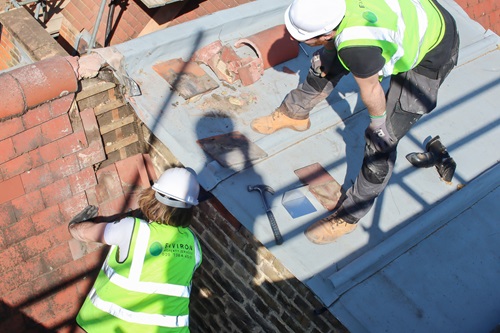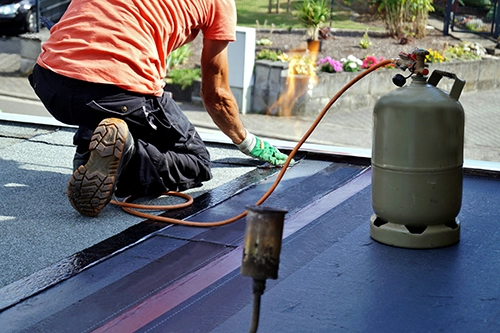- About Us
- Services
- Blog
- Contact
Need a quote?
Roof replacement in London might sound like a major expense, but in the long run it can be more than worth it as an investment. To explain why, we’ve put together this helpful list of three reasons why you might want to replace your roof this summer.




If your roof is old, then sooner or later you may be forced to repair or replace it, whether you like it or not. The fact of the matter is that older roofing materials tend to be less sturdy, giving them a more limited lifespan than modern equivalents.
Furthermore, if your roof is damaged and you don’t realise it, then that can cause other issues for your property such as damp as a result of leaking water.
With modern materials, you can give yourself peace of mind that you’ve got a sturdy, long-lasting roof over your head.
But it’s not just about peace of mind. When we said a new roof can be an investment, we meant it.
Many people don’t realise just how much money they lose on inefficient heating. This can happen for any number of reasons, from a faulty boiler to poor-quality windows, but one of the biggest causes of inefficient central heating is a poorly insulated roof.
After all, heat travels upwards. If it’s going to escape anywhere, then it will escape through the roof. That’s why a well-insulated roof is imperative to trapping the heat in while keeping the wind and rain out.
While the ideal time for roof replacement in London is autumn, the sooner you get the job done, the better. Although the summer heat can cause delays, Autumn tends to be our busiest time of year, which can push jobs further and further back if we’re booked up.
What’s really important, however, is that you don’t wait all the way until the winter because by then the weather will have turned cold. Not only does this increase the likelihood of damage, but it can also slow the replacement process down as we’re forced to work shorter days due to the combination of frost and poor light conditions.
If you’re looking for first-rate roof replacement in London, then get in touch with us today by calling 020 3535 6957 or emailing us at info@environroofingservices.co.uk.
It depends on the construction, but the minimum weight a flat roof must be capable of bearing is 300lbs. This refers to a concentrated weight where a load is positioned on just one area of the roof. So, for example, a commercial flat roof can approximately support a 300lb HVAC unit in a 2.5×2.5ft single space.
If you opt for a flat roof anywhere on your property, remember that it comes with a need for proper maintenance. Low-slope roofing London-wide should be checked every six months or so, or after spells of bad weather, to spot any signs of damage. No matter how small, these should be addressed before they escalate. Remove any debris (leaves, twigs and so on) regularly to avoid these blocking the gutters and allowing water to pool and stand on the roof.
If there are trees in the close vicinity, keep them cut back to reduce the amount of foliage that falls on your flat roof. And check internally for signs of moisture, dampness or water damage on a regular basis. Spotting problems early means resolving them will be cheaper in the long run.

Building a flat roof can be done in three ways. The simplest and most cost-effective choice for levelled roofing London-wide is to construct a warm roof where a roofing membrane is placed over the insulation that keeps the timber structure warm. Another option is to create a cold roof where insulation is positioned between the rafters under the ply roof covering. This is commonly applied to flat-roofed extensions.
The third method is the hybrid roof that contains diverse elements. Their designs require a gap of ventilation above a warm roof to prevent excess moisture within the roof structure.
If you’re looking for flat roofing local contractors, don’t just select the first firm you come across. Find a roofing company that’s been in business for a while and can demonstrate a good track record in installing, repairing, and replacing flat roofs specifically. Ask for recommendations from your own network or from a local trade association. If you need refurbishment work done to 50% or more of your roof, you’ll need a roofing contractor who can self-certify their work under the Competent Person Scheme. Otherwise, the Building Control department at your local authority will need to approve the job before it begins.
Ask whether they are covered by liability insurance and how long they’ll guarantee the work they will carry out. And never just opt for the cheapest quote unless you’re quite sure they’re the best company for the job. You can’t afford to compromise on your roof as the structural integrity of your property depends on it.
Ensuring your flat roof will comply with building regulations before installation can save property owners time, money and stress. First, the roof must have a slope of around 1:80, with water draining away to one or two roof edges. Waterproofing must be extended up to the adjacent walls with at least 150 mm from the surface of the roof.
Contractors must install ventilation in cold roofs. For warm roofs, the deck must be bonded with a VCL. The roof should have the capacity to withstand strong winds and be sturdy enough to take an individual’s weight. Finally, check whether planning permission is needed. Typically, this is only required if you live in a conservation area or a listed building, or are making significant changes to an existing roof.
If you’re looking for top roofing solutions at competitive rates, check out our range of roofing services at Environ Roofing Company London. To get started, call one of our representatives today!

